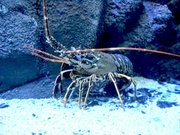By NICO SCAVELLA
Tribune Staff Reporter
nscavella@tribunemedia.net
NEW research on the Caribbean spiny lobster has led to one international marine biologist advocating the conservation of the Bahamas' seagrass habitats, as findings indicate the underwater gardens are responsible for nearly $20m in local lobster production.
Dr Nicholas Higgs, Deputy Director of the Marine Institute at Plymouth University, England, said that the "high productivity" of local lobster production is largely due to their consumption of lucinid clams, which are found in the seagrass beds in Bahamian waters.
According to Dr Higgs, a stable isotope analyses of the tissues of Caribbean spiny lobsters indicate that the creatures obtain "about a fifth" of their diet from lucinid clams and that in some lobster populations "that figure almost doubled".
The significance of those clams, specifically the Tiger Lucine clam, Dr Higgs said, is that they make their own food with the help of chemosynthetic bacteria - organisms that synthesise organic compounds using the energy derived from organic or inorganic materials - living in their gills.
According to Dr Higgs, that "chemosynthetic food source" represents an "alternative food pathway to the traditional photosynthesis (the process of harnessing and converting sunlight energy into chemical energy) based food chain."
As such, Dr Higgs explained that by consuming the clams, which he said often live "deep down" in the ocean sediment, seemingly making them "inaccessible," the lobsters are "taking advantage of extra food that few other predators seem to be able to access".
To support his claims, Dr Higgs referred to a recent study conducted by he and some of his colleagues in which they monitored spiny lobsters at 10 locations across the Great Bahama Bank. On multiple occasions, Dr Higgs said, they caught spiny lobsters "in action, eating lucinid clams".
"Although chemosynthetic organisms were known to inhabit certain shallow ecosystems like seagrass beds and mangrove swamps, they were thought to be 'dead ends' in the good chain or pretty minor at best," Dr Higgs said on Friday. "It shouldn't have been a surprise because they can be some of the most abundant animals in seagrass beds, but they often live deep down in the sediment so people thought that they were generally inaccessible. It was pretty surprising to find that they help support a major economically important fishery species."
More importantly, Dr Higgs said the study's findings provide the "first empirical evidence" that chemosynthetic primary production contributes to the productivity of a "lucrative commercial fishery," which he says is worth over $17m in local lobster production.
Dr Higgs also said the study shows that "seagrass habitats and chemosynthetic productivity should be reconsidered in conservation and environmental management going forward".
Nonetheless, Dr Higgs said he is interested in exploring and finding out which other animals are eating the clams.
"We are just beginning to scratch the surface of understanding just how important these alternative forms of food production are in marine and freshwater ecosystems," he said.





Comments
Use the comment form below to begin a discussion about this content.
Sign in to comment
Or login with:
OpenID